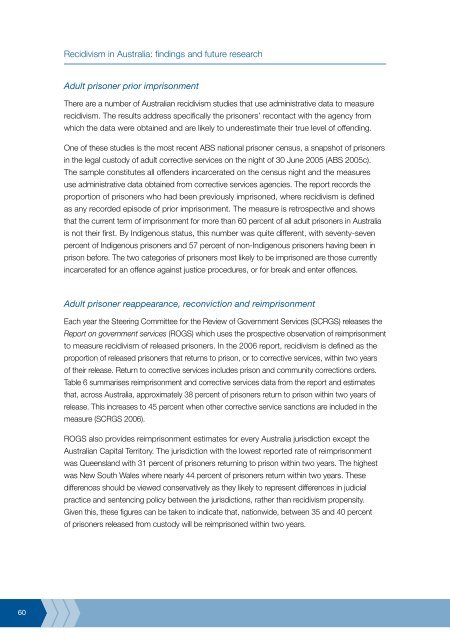Recidivism in Australia : findings and future research - Australian ...
Recidivism in Australia : findings and future research - Australian ...
Recidivism in Australia : findings and future research - Australian ...
You also want an ePaper? Increase the reach of your titles
YUMPU automatically turns print PDFs into web optimized ePapers that Google loves.
60<br />
<strong>Recidivism</strong> <strong>in</strong> <strong>Australia</strong>: f<strong>in</strong>d<strong>in</strong>gs <strong>and</strong> <strong>future</strong> <strong>research</strong><br />
Adult prisoner prior imprisonment<br />
There are a number of <strong>Australia</strong>n recidivism studies that use adm<strong>in</strong>istrative data to measure<br />
recidivism. The results address specifically the prisoners’ recontact with the agency from<br />
which the data were obta<strong>in</strong>ed <strong>and</strong> are likely to underestimate their true level of offend<strong>in</strong>g.<br />
One of these studies is the most recent ABS national prisoner census, a snapshot of prisoners<br />
<strong>in</strong> the legal custody of adult corrective services on the night of 30 June 2005 (ABS 2005c).<br />
The sample constitutes all offenders <strong>in</strong>carcerated on the census night <strong>and</strong> the measures<br />
use adm<strong>in</strong>istrative data obta<strong>in</strong>ed from corrective services agencies. The report records the<br />
proportion of prisoners who had been previously imprisoned, where recidivism is def<strong>in</strong>ed<br />
as any recorded episode of prior imprisonment. The measure is retrospective <strong>and</strong> shows<br />
that the current term of imprisonment for more than 60 percent of all adult prisoners <strong>in</strong> <strong>Australia</strong><br />
is not their first. By Indigenous status, this number was quite different, with seventy-seven<br />
percent of Indigenous prisoners <strong>and</strong> 57 percent of non-Indigenous prisoners hav<strong>in</strong>g been <strong>in</strong><br />
prison before. The two categories of prisoners most likely to be imprisoned are those currently<br />
<strong>in</strong>carcerated for an offence aga<strong>in</strong>st justice procedures, or for break <strong>and</strong> enter offences.<br />
Adult prisoner reappearance, reconviction <strong>and</strong> reimprisonment<br />
Each year the Steer<strong>in</strong>g Committee for the Review of Government Services (SCRGS) releases the<br />
Report on government services (ROGS) which uses the prospective observation of reimprisonment<br />
to measure recidivism of released prisoners. In the 2006 report, recidivism is def<strong>in</strong>ed as the<br />
proportion of released prisoners that returns to prison, or to corrective services, with<strong>in</strong> two years<br />
of their release. Return to corrective services <strong>in</strong>cludes prison <strong>and</strong> community corrections orders.<br />
Table 6 summarises reimprisonment <strong>and</strong> corrective services data from the report <strong>and</strong> estimates<br />
that, across <strong>Australia</strong>, approximately 38 percent of prisoners return to prison with<strong>in</strong> two years of<br />
release. This <strong>in</strong>creases to 45 percent when other corrective service sanctions are <strong>in</strong>cluded <strong>in</strong> the<br />
measure (SCRGS 2006).<br />
ROGS also provides reimprisonment estimates for every <strong>Australia</strong> jurisdiction except the<br />
<strong>Australia</strong>n Capital Territory. The jurisdiction with the lowest reported rate of reimprisonment<br />
was Queensl<strong>and</strong> with 31 percent of prisoners return<strong>in</strong>g to prison with<strong>in</strong> two years. The highest<br />
was New South Wales where nearly 44 percent of prisoners return with<strong>in</strong> two years. These<br />
differences should be viewed conservatively as they likely to represent differences <strong>in</strong> judicial<br />
practice <strong>and</strong> sentenc<strong>in</strong>g policy between the jurisdictions, rather than recidivism propensity.<br />
Given this, these figures can be taken to <strong>in</strong>dicate that, nationwide, between 35 <strong>and</strong> 40 percent<br />
of prisoners released from custody will be reimprisoned with<strong>in</strong> two years.















